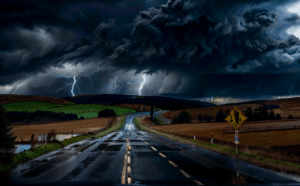Storm Floris has swept across Tayside, Fife, and Central Scotland, bringing unseasonably strong and potentially hazardous winds that have significantly impacted communities, including those across Perth and Kinross. The Met Office escalated its warnings for wind to both yellow and amber levels, with amber signifying a “danger to life” from large waves and flying debris, as gusts approached 90mph in some exposed areas.
The storm’s fierce arrival initiated widespread disruption across various sectors, from transportation networks to public services and popular local attractions. Extensive Travel Disruption Affects Perth and Kinross Commuters
The region’s rail network faced severe challenges. Train operator LNER issued a stark warning, advising customers against travel north of Newcastle on Monday, a directive that directly impacted routes serving Perth and its surrounding areas. Further compounding commuter woes, Network Rail imposed a 50mph speed restriction on all other train services from 9am, and from midday, all lines north of Fife and Perth were completely shut down due to safety concerns. This included crucial connections linking Edinburgh to Perth, Dundee, and Aberdeen, as well as local services from Dunblane to Perth, and lines extending further north towards Inverness. While train travel was severely curtailed, ScotRail offered some relief by confirming that all cancelled tickets would be honoured for journeys on Tuesday. Rapid response teams were also deployed to address incidents, including the swift clearance of a fallen tree from overhead wires near Stirling, which had initially blocked tracks.
Road conditions proved equally challenging. The vital Tay Road Bridge, a key artery connecting Fife with Dundee, was forced into a full closure for all vehicles as wind gusts soared above 80mph, compelling drivers to navigate diversions via Perth. Earlier, the bridge had already restricted access for double-decker buses and implemented a 30mph speed limit. Neighbouring Forth Road Bridge, along with the Kincardine and Clackmannan Bridges, also saw closures for high-sided vehicles, necessitating diversions for bus services and affecting residents in areas like Kinross. As a result, certain Citylink and Megabus services were rerouted through Stirling, bypassing their usual stops in Kinross.
Closer to home in Perth and Kinross, the storm made its presence felt on local routes. The A9 near Dunblane experienced restrictions following a road traffic incident. The A9 at Birnam, a key route often used by Perthshire residents, was also temporarily closed in both directions due to a fallen cable, though it later reopened. Stirling’s road network, adjacent to Perth and Kinross, reported numerous incidents of fallen trees and debris, including on the A84 and A9 Airthery Road, and sections of the A873 and B822. Power Outages and Service Interruptions
Electricity supplies across Perth and Kinross experienced significant interruptions, with power cuts reported in communities such as Milnathort, Methven, Braco, Aberfeldy, Killin, Kinloch Rannoch, Pitlochry, and Meikleour. Scottish and Southern Electricity Networks (SSEN) acknowledged the broad impact, mobilising additional field engineers and staff to address the outages. The utility also proactively reached out to over 100,000 vulnerable customers with preparedness advice, and conceded that full restoration of power might extend beyond Monday’s end. Broader outages were also reported across Fife, Dundee, and Angus.
Local services and popular attractions also took precautionary measures. Scone Palace, a beloved Perthshire landmark, closed its gardens for the day, prioritizing visitor safety due to the strong winds, though the palace itself remained open with discounted entry. Waste management services were notably affected; Angus Council suspended all bin collections and closed recycling centres from noon, a step mirrored by Dundee City Council for its collections and recycling facilities. Stirling’s Lower Polmaise Household Waste and Recycling Centre also ceased operations.
Beyond essential services, recreational and cultural sites felt the storm’s impact. Dundee Airport saw several flight cancellations, impacting connections to Heathrow and Kirkwall. All outdoor sports and activity facilities managed by Active Dundee, including Camperdown Wildlife Centre, were closed, and ANGUSalive Countryside Adventure cancelled its camps and sessions, advising the public to avoid country parks altogether. Even the iconic National Wallace Monument in Stirling closed its doors, offering refunds or alternative visit dates for ticket holders.
The intensity of the storm was underscored by recorded wind speeds, with Glenshee, bordering Perthshire, reporting astonishing gusts of 106mph. Kinross experienced winds of 60mph, while the Angus coast registered 59mph. Forecasters had anticipated the strongest winds to peak between 2pm and 4pm on Monday, and observations largely confirmed these predictions. Staying Safe Amidst the Storm
In response to the hazardous conditions, Police Scotland issued a comprehensive safety advisory. Residents were strongly urged to ensure their mobile phones were fully charged, plan their journeys with alternative routes in mind, and carry essential supplies such as fuel, warm clothing, food, and water in case of unexpected delays. Emphatically, authorities stressed the importance of strictly adhering to all road closure signs, warning that ignoring them could impede emergency services and recovery vehicles. The public was advised to remain vigilant, monitoring local media broadcasts, official weather updates from the Met Office and Ready Scotland, and travel information from @OfficialTrafficScotland on platforms like X (formerly Twitter).
As Storm Floris gradually recedes, communities across Perth and Kinross, and indeed wider Central Scotland, will begin to assess the full extent of the damage and work towards recovery from this unseasonably severe weather event.
The storm’s fierce arrival initiated widespread disruption across various sectors, from transportation networks to public services and popular local attractions. Extensive Travel Disruption Affects Perth and Kinross Commuters
The region’s rail network faced severe challenges. Train operator LNER issued a stark warning, advising customers against travel north of Newcastle on Monday, a directive that directly impacted routes serving Perth and its surrounding areas. Further compounding commuter woes, Network Rail imposed a 50mph speed restriction on all other train services from 9am, and from midday, all lines north of Fife and Perth were completely shut down due to safety concerns. This included crucial connections linking Edinburgh to Perth, Dundee, and Aberdeen, as well as local services from Dunblane to Perth, and lines extending further north towards Inverness. While train travel was severely curtailed, ScotRail offered some relief by confirming that all cancelled tickets would be honoured for journeys on Tuesday. Rapid response teams were also deployed to address incidents, including the swift clearance of a fallen tree from overhead wires near Stirling, which had initially blocked tracks.
Road conditions proved equally challenging. The vital Tay Road Bridge, a key artery connecting Fife with Dundee, was forced into a full closure for all vehicles as wind gusts soared above 80mph, compelling drivers to navigate diversions via Perth. Earlier, the bridge had already restricted access for double-decker buses and implemented a 30mph speed limit. Neighbouring Forth Road Bridge, along with the Kincardine and Clackmannan Bridges, also saw closures for high-sided vehicles, necessitating diversions for bus services and affecting residents in areas like Kinross. As a result, certain Citylink and Megabus services were rerouted through Stirling, bypassing their usual stops in Kinross.
Closer to home in Perth and Kinross, the storm made its presence felt on local routes. The A9 near Dunblane experienced restrictions following a road traffic incident. The A9 at Birnam, a key route often used by Perthshire residents, was also temporarily closed in both directions due to a fallen cable, though it later reopened. Stirling’s road network, adjacent to Perth and Kinross, reported numerous incidents of fallen trees and debris, including on the A84 and A9 Airthery Road, and sections of the A873 and B822. Power Outages and Service Interruptions
Electricity supplies across Perth and Kinross experienced significant interruptions, with power cuts reported in communities such as Milnathort, Methven, Braco, Aberfeldy, Killin, Kinloch Rannoch, Pitlochry, and Meikleour. Scottish and Southern Electricity Networks (SSEN) acknowledged the broad impact, mobilising additional field engineers and staff to address the outages. The utility also proactively reached out to over 100,000 vulnerable customers with preparedness advice, and conceded that full restoration of power might extend beyond Monday’s end. Broader outages were also reported across Fife, Dundee, and Angus.
Local services and popular attractions also took precautionary measures. Scone Palace, a beloved Perthshire landmark, closed its gardens for the day, prioritizing visitor safety due to the strong winds, though the palace itself remained open with discounted entry. Waste management services were notably affected; Angus Council suspended all bin collections and closed recycling centres from noon, a step mirrored by Dundee City Council for its collections and recycling facilities. Stirling’s Lower Polmaise Household Waste and Recycling Centre also ceased operations.
Beyond essential services, recreational and cultural sites felt the storm’s impact. Dundee Airport saw several flight cancellations, impacting connections to Heathrow and Kirkwall. All outdoor sports and activity facilities managed by Active Dundee, including Camperdown Wildlife Centre, were closed, and ANGUSalive Countryside Adventure cancelled its camps and sessions, advising the public to avoid country parks altogether. Even the iconic National Wallace Monument in Stirling closed its doors, offering refunds or alternative visit dates for ticket holders.
The intensity of the storm was underscored by recorded wind speeds, with Glenshee, bordering Perthshire, reporting astonishing gusts of 106mph. Kinross experienced winds of 60mph, while the Angus coast registered 59mph. Forecasters had anticipated the strongest winds to peak between 2pm and 4pm on Monday, and observations largely confirmed these predictions. Staying Safe Amidst the Storm
In response to the hazardous conditions, Police Scotland issued a comprehensive safety advisory. Residents were strongly urged to ensure their mobile phones were fully charged, plan their journeys with alternative routes in mind, and carry essential supplies such as fuel, warm clothing, food, and water in case of unexpected delays. Emphatically, authorities stressed the importance of strictly adhering to all road closure signs, warning that ignoring them could impede emergency services and recovery vehicles. The public was advised to remain vigilant, monitoring local media broadcasts, official weather updates from the Met Office and Ready Scotland, and travel information from @OfficialTrafficScotland on platforms like X (formerly Twitter).
As Storm Floris gradually recedes, communities across Perth and Kinross, and indeed wider Central Scotland, will begin to assess the full extent of the damage and work towards recovery from this unseasonably severe weather event.


